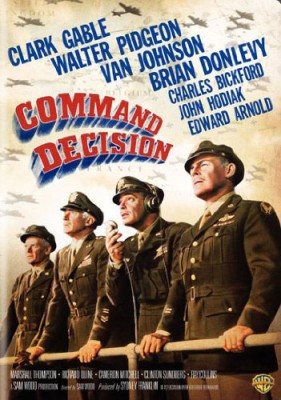30 Dec Command Decision
(1948) Clark Gable wrestles with the agonizing decisions associated with the job of commanding the B-17 bomber crews. See what was happening behind the scenes by the head guys who called the shots.
Someone told me early on in my research that this and Twelve O’Clock High were two movies that were the most realistic as to what was happening “over there.”
Command Decision on amazon.com
Watch a trailer on the Turner Class Movies site.



Rowdy
Posted at 20:05h, 22 JulyI gave you the steer to this film and 12 O’Clock High…glad to see you liked them; also, happy to see you’ve made such wonderful progress with your fine project. This film portrays the end (1942-43) result of an internal Army battle that had been playing out during the 1920s and 1930s. During that period, aircraft had mostly been the small pursuit planes, designed to be used as support for Army ground movements. There had been a nearly constant battle between members of the Army Air Service and the Army brass, consisting entirely of Infantry, Artillery, and Armored subdivisions. Those in the Air Service, since about 1915, had contended that the Air Service needed to be its own service branch, equal to the Army and Navy, in order to effectively direct their own development and applications. Stemming from this internal rivalry was a small group of airmen who collectively became known as the “Bomber Mafia” so named for their unwavering belief in the untried tactic of “precision daylight bombing” as a means of denying the enemy of its means of waging war. Their initial belief, as portrayed in this film, was that by arming the bombers with a lot of big machine guns, the bombers could effectively defend themselves from any enemy attack. This film is a portrayal of how wrong they were and how dear the losses early in the war actually were. Not until the introduction of large numbers of P-51 Mustangs in late 1943 to early 1944, were the bombers adequately protected over Germany….except, of course, from the flak guns below. This film is set before the arrival of the P-51s and shows the precarious state our early air war really was at that time. Members of the “Bomber Mafia” loosely portrayed in the film are Ira Eacker (the general) and Frank Andrews (Gable). “The Boss” in Washington is Hap Arnold. Others not portrayed in the film, but who would play large roles in WWII were Jimmy Doolittle, Hoyt Vandenbeg, Carl Spaatz, and Curtis LeMay. Their support of daylight precision bombing finally proved correct, but their notion of the bombers being self sufficient was not.
Rowdy
Pat
Posted at 08:20h, 23 JulyGreat to hear from you Rowdy. I look forward to your insights, always. THANKS, Pat